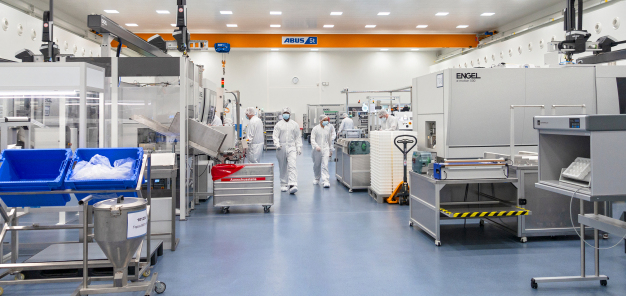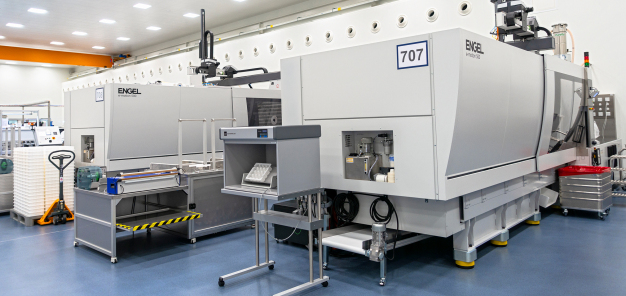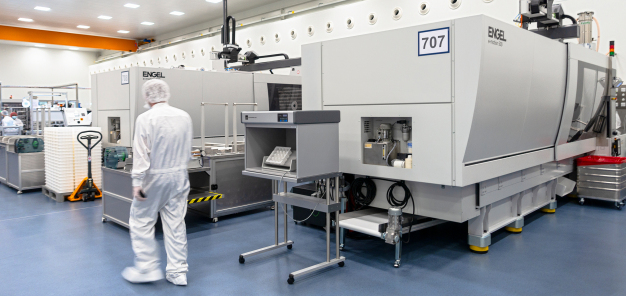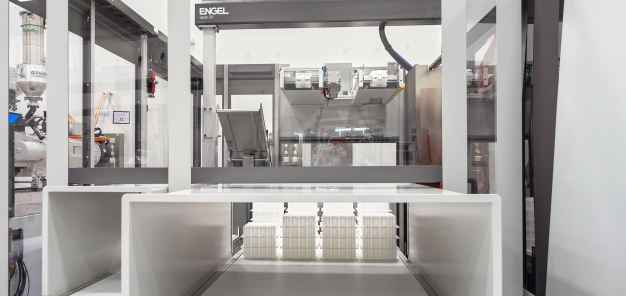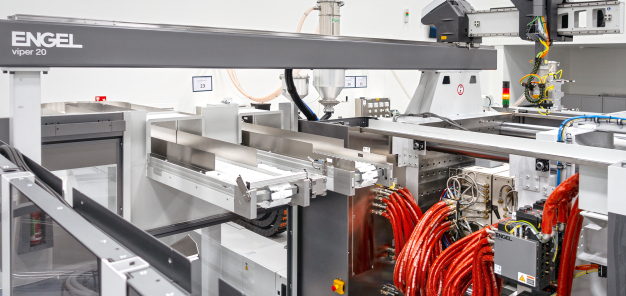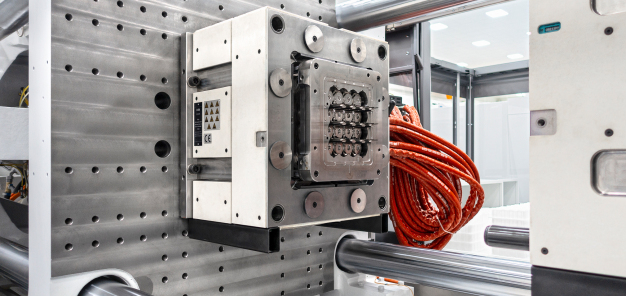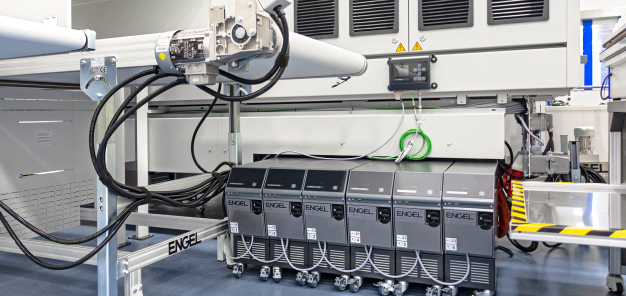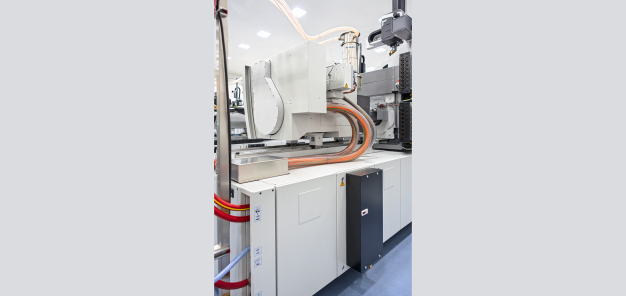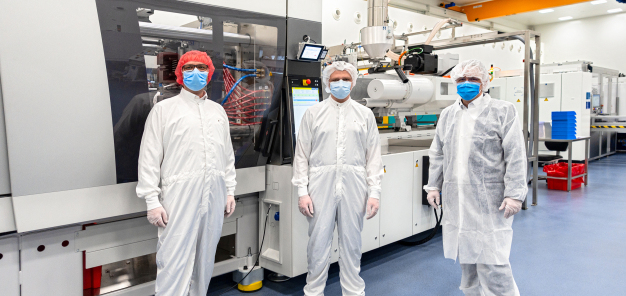For a short time-to-market
During Corona pandemic, Röchling Medical relies on ENGEL
All-electric, high-performance machines by ENGEL combine efficiency with precision. But the decisive factor which prompted Röchling Medical to invest in no less than eight e-motion machines was the overall package, including digitalisation. In the production of nest-and-tub systems, the two largest machines, each with a clamping force of 5000 kN, impress with self-regulating temperature control processes.
Nest-and-tub systems provide packaging for liquid pharmaceuticals in the form of vials or pre-filled syringes. Covid-19 has led to a massive increase in global demand, as vaccine vials are also offered in this packaging form. For Röchling Medical at the Brensbach site in Germany, nest-and-tub systems are a new application which, above all, demands one thing from injection moulding production: flexibility. Focused on vials, five sizes of nest inserts are currently produced at Röchling on two new all-electric ENGEL e-motion injection moulding machines. The same applies to the standardised tubs for all nest sizes, which require the highest clamping force of 5000 kN across the entire range of parts. In order to be able to set up the moulds flexibly, the two machines intended for this application were ordered in size 500 and designed identically. “In the near future, the two 5000 kN machines will be in action 24/7 with nest-and-tub production,“ says Marco Treuner, Technical Project Manager at Röchling Medical.
Extra features boost efficiency in the cleanroom
The dimensions of the nest-and-tub packaging are standardised so that they can be used in filling and sterilisation systems of different types and by different suppliers. During the entire filling and production process, the vials remain in the nest and can therefore neither fall over nor collide with each other. The vials, which are mostly made of glass, are well protected in the honeycomb structure. For 50 ml tubs, there are 16 vials in the nest. The lower the filling quantity, the more vials there is room for in a package, and the more honeycombs the nest inserts have. POM is used for this demanding component geometry. The material reliably withstands cleaning before the filling process and is also economical. But due to its pronounced shrinkage, POM places high demands on the stability and repeatability of the injection moulding process. Added to this is the mould design with many long, closely spaced cores. “We need very rigid mould mounting platens and particularly small centring diameters to avoid overmoulding even with the very large platens of the e-motion 500,“ says Treuner. Designed for maximum performance, the e-motion machines come with highly rigid platens as standard. ENGEL designed the platens with a particularly small centring diameter of 80 mm specifically for the nest-and-tub application at Röchling.
“ENGEL offered us the best overall package,“ says Joachim Lehmann, Director Business Unit Medical Europe at Röchling, explaining the investment decision. The two e-motion 500 injection moulding machines in clean room design are equipped with a linear robot from the viper series as well as GMP-compliant belt conveyors – both from ENGEL's in-house development and production. In addition, there are special solutions tailored for Röchling that make the use of the very large injection moulding machines in the cleanroom even more efficient. The cable ducts are enclosed, smaller cable bundles are routed in hoses, and the control cabinets also have their own heat exchangers to prevent air turbulence at this point. Since the nest components are still too unstable to stack when they are taken off the mould, additional U-shaped belt conveyors were installed above the clamping unit as post-cooling section. Only 15 minutes after part removal, the viper robot picks up the components from the post-cooling conveyor and cycles them out via the larger belt conveyors for stacking in boxes.
Smart temperature control assistance for stable processes and more energy efficiency
In addition to the very high precision of the all-electric high-performance machines, extremely constant temperature control is crucial for the dimensional accuracy of the demanding POM parts, as Marco Treuner explains. “We have to ensure repeatable quality as early as in the production process.“ Quality controls take place several times. Both at the Brensbach plant and at the customer's site. If the customer is located in the USA – as is the case with the current order – sufficient time elapses between production and quality control, and the recrystallisation process, i.e. shrinkage, is finished by then. At Röchling, part aging is simulated in parallel over six months using a heat-aging process.
For precisely repeatable temperature control, Röchling Medical took a step toward digitalisation. Both machines use iQ flow control, the smart temperature control assistant by ENGEL. Equipped with six e-flomo temperature control water manifolds and the same number of temperature control devices from the ENGEL e-temp series, the system relies on the software to control and regulate itself over the entire production batch and keeps the temperature control conditions constant. The temperature difference acts as a control variable for dynamic individual circuit temperature control.
In the ENGEL solution, the injection moulding machines and the temperature control devices communicate with each other via OPC UA. In this way, iQ flow control is able to adapt the pump speed in the temperature control devices to the actual demand. This interaction combines temperature stability with very high productivity and energy efficiency. “We can already see, in the short time after the start-up, that the pumps are regulating down to a significant extent. In some cases, they are running at just under 30 percent output instead of constantly at 100 percent,“ reports Treuner. The decisive factor for the investment in iQ flow control was the material, but the benefit for the company is far greater due to the energy savings. “We take care to keep the ecological footprint of our production facilities small and also take this into account when selecting our suppliers,“ emphasises Lehmann. Röchling is ISO 50001 certified. The energy consumption displays of the e-motion machines support the processor in systematic energy management.
Medical machines take priority
The two new large production cells are part of a comprehensive package that ENGEL delivered to Brensbach in recent weeks. All eight new e-motion machines with clamping forces of 1600, 2800 and 5000 kN are used for cleanroom applications in the fields of pharmaceutical packaging, diagnostics and medical technology. In addition to the nest-and-tub systems, Röchling Medical also produces racks for pipette tips and microtiter plates on ENGEL machines. As a competence centre for injection moulding technology, the Brensbach plant combines injection moulding production, assembly and mould making. All-electric drive technology is the factory standard there. In addition to high precision, the aim is to avoid oil in the cleanroom to the extent possible. In addition, fast machine motion is crucial. While the nest parts have cycle times of up to 40 seconds, the tubs require very high output with a cycle time of 10 seconds.
Triggered by Covid-19, the two large 5000 kN machines in particular were subject to enormous time pressure. “We adjusted our processes right at the beginning of the pandemic and prioritised medical machines in all plants,“ says Holger Kast, sales engineer at ENGEL Deutschland's Stuttgart site. “For the Röchling project, we also accelerated order processing and postponed the red tape.“
Another special feature of ENGEL contributed to rapid start-up of the machines: the machines were delivered in two parts at no extra charge. “Our airlock is too small for a fully assembled 5000 kN machine,“ explains Treuner. “If we'd had to open up the cleanroom to take in the machines, this would have involved a production stoppage of an entire week.“ And that would have affected several products at the same time, because there are more than ten production cells in the large GMP-C cleanroom.
Not least system business ensures a short time-to-market. “In ENGEL, we have a central point of contact and we communicate directly,“ says Lehmann. “Right from the outset, the entire production cell was perfectly planned and all the components were precisely tuned. ENGEL made it easy for us right from the early phase. When it comes to complex production cells, there are not many companies who can achieve that at this speed.
ENGEL AUSTRIA GmbH
4311 Schwertberg
Austria





